You can also be interested in these:
- Do solar panels work at night? The anti-solar panels
- AMD Zen 3 vs Zen 4: The evolution and revolution
- What is the AMD FidelityFX Super Resolution?
- CES 2022: The year’s most anticipated tech event
Solar energy is perhaps one of the most used renewable energies in the world not only in factories, companies or residence buildings. It is also vital in the use of agriculture and has become one of the best energy resources in the world. Greenhouses benefits directly from the solar energy for its normal functionality. This sounds like the perfect marriage: A system that requires sun light and a power system that feeds from the same resource. These factors make the greenhouse solar panels almost the go-to alternative to provide your crop structure of electricity.

Smart greenhouses that operate without connection to the electricity grid, that require less water for crops and that also make them grow even better than in conventional farms using plastic. This is what the Californian University of Santa Cruz achieved, which, after testing a new solar technology in real farms, has just shown that dual-use greenhouses (for energy capture and growing food) offer promising results regarding production and electrical self-sufficiency.
Greenhouse solar panels as a renewable power source
Over the years the symbiosis between the agricultural world and renewable energy sources has led into a considerable increment on the use of photovoltaic greenhouses. This is no other that the application of solar panel systems to capture and transform the solar energy in Greenhouses.
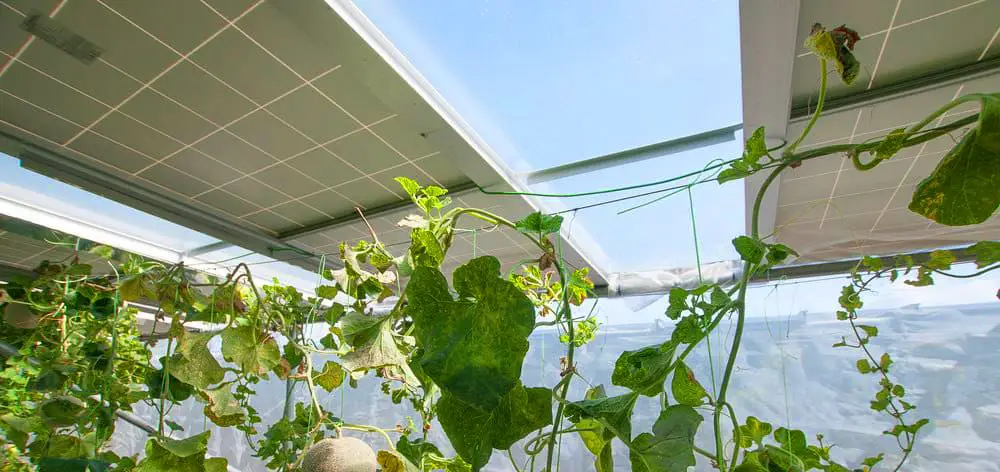
Producing solar energy being able to take advantage of agricultural areas without jeopardizing the quality of the final product is a big concern among greenhouse owners. The truth is, due to the nature of the energy source, you are not only producing electricity out of it, you are also creating the perfect environment to ensure a good growth and development of the crops.
“We have shown that smart greenhouses can capture solar energy without reducing plant growth,” synthesizes one of the drivers of the aforementioned research work, according to Professor Michael Loik. In fact, this is clear from the tests carried out in three farms equipped with a technology specially designed for dual-use greenhouses. After growing 20 varieties, including tomato, cucumber, lemon, lime or strawberry, the results are surprising.
Professor Rakesh Agrawal, from the area of chemical engineering at Purdue University, Indiana, is working on the development of a method for farmers in the United States to capture solar energy on their land without the problems of blocking the light so their plants receive it, which would allow a supply compatible with the environment, under normal conditions.
A team led by Agrawal aims to capture infrared radiation for energy production while letting sunlight through to crops. For the professor, the concept is based on “building a structure in a greenhouse, a farmer will be able to grow corn while monitoring the land and making sure to produce electricity” in addition to the natural development of plants.
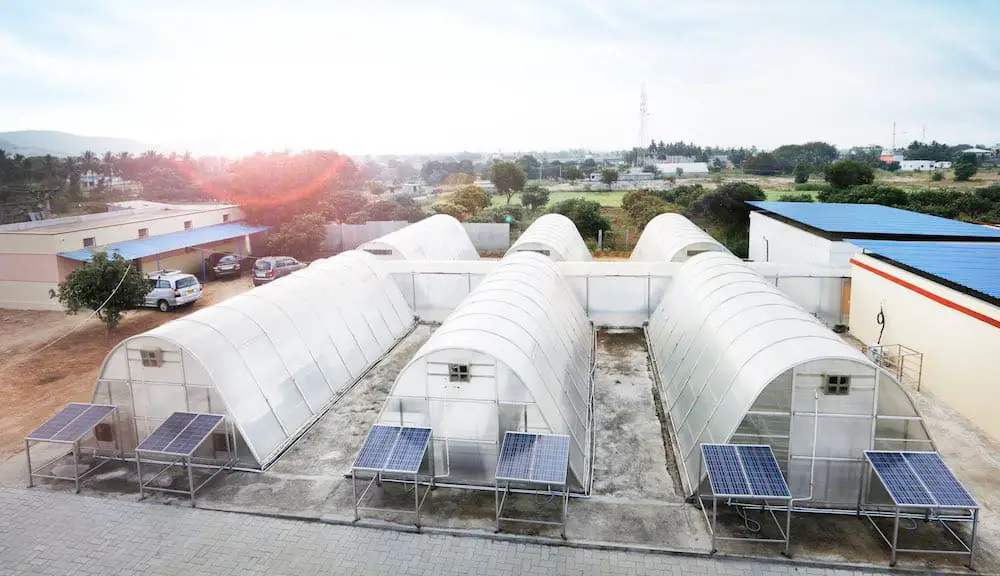
Rakesh Agrawal is a researcher awarded with the American national prize for technology and innovation, in 2011. He has currently received a grant of 2.5 million dollars, just over 2 million euros, from the National Foundation of Sciences, which are intended to make a prototype to demonstrate their theories.
Regarding the structure that can be proposed to carry out the work, Agrawal assures that “there are dozens of possible structures that we can build. Some are even cheaper than those that are being made at the moment, that is why we want to build on farms and do experiments to demonstrate viability ”. 80% of the products grown were not affected in any way by the installation of the greenhouse solar panels system to generate energy. The remaining 20% grew better than in a conventional farm. In addition, in cases such as tomato, the team verified how their water needs were reduced. “The plants needed 5% less water to reach the same level of growth as in a conventional greenhouse,” says Loik.
Wavelength-Selective Photovoltaic Systems (translucent panels)
The ambition to create transparent solar panels is not new. In fact, in recent years it has been sought to satisfy this foreseeable future demand with some research. The objective has not always been successful. But there are signs of its viability.
Recently, an investigation by South Korean scientists proposed a much cheaper formula than those proposed to date. It was about creating transparent solar panels thanks to tiny holes in their surface. These gaps would be enough for light to pass through. But at the same time there would be enough surface area to generate power.
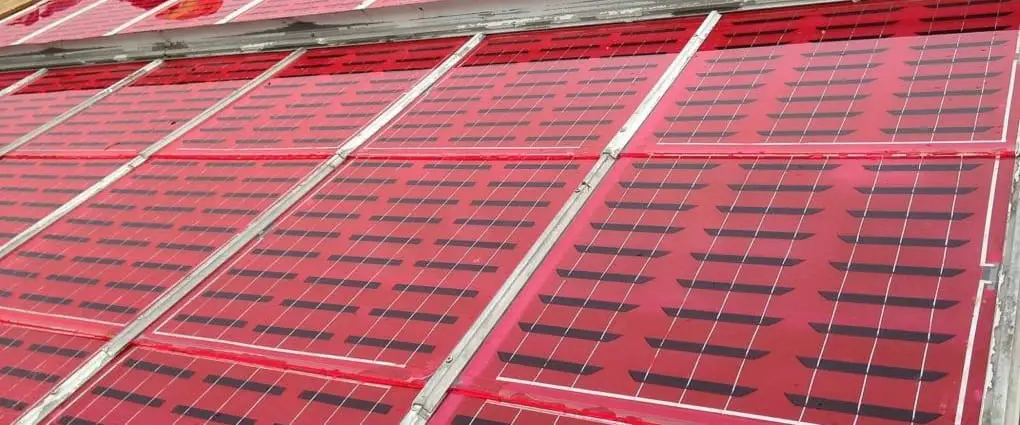
In this case, it was about creating solar windows, which could generate energy for buildings. Photovoltaic energy has become one of the elements of modern construction. At least that’s how it is hoped to be, since the benefits derived from this are large.
They would also be in a greenhouse. With this structures in mind a team of American scientists has looked to separate certain wavelengths. Much of the energy that a solar panel obtains comes from wavelengths that plants do not use for photosynthesis.
Thus, the idea is to create transparent solar panels with a double objective. On the one hand, they have to allow the passage of light for the plants. On the other hand, they have to take advantage of the light that is not used for photosynthesis to obtain energy.
The researchers have created a computational model to calculate the energy that these panels should obtain. It is not a trivial matter. A greenhouse needs sun for the plants, but it also needs to maintain an optimal temperature for their growth. To this is probably added the automation of the irrigation system. The objective that greenhouses are neutral in carbon footprint.
Sometimes it is necessary to lower the temperature of the greenhouse. Here the panels are a great help, as they reflect infrared radiation, thus preventing overheating in summer. Other times you have to increase the temperature. Taking into account that the passage of wavelengths would be selective, the researchers have calculated the amounts of energy according to different regions.
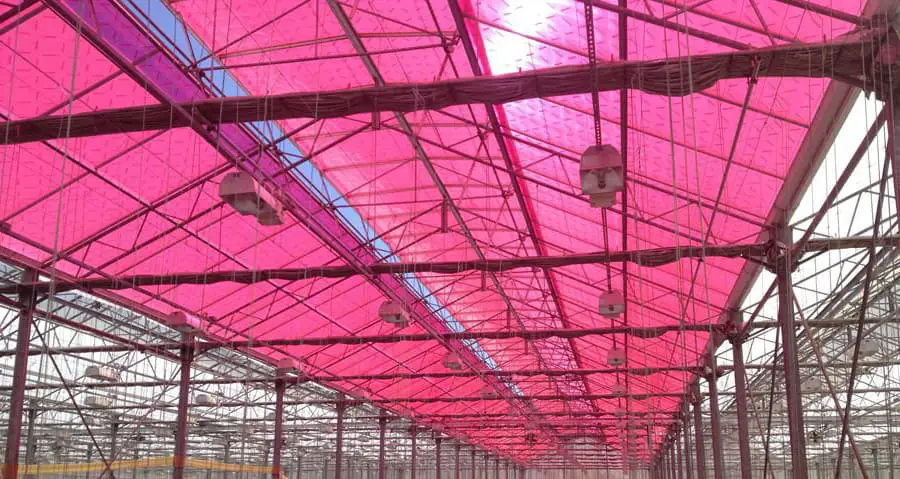
These results were possible thanks to the development of a new technology created specifically for this purpose. It is WSPV (Wavelength-Selective Photovoltaic Systems), a selective wavelength photovoltaic system that consists of the installation of transparent roof panels with a luminescent magenta tint. The equipment absorbs the light and transfers the energy to small photovoltaic strips in which electricity is produced.
At the same time, this innovation combines luminescent solar cells with conventional silicon panels. These absorbs part of the blue and green wavelengths, but transmits all the others to the crops. The ones transmitted are precisely the ones responsible for the photosynthesis.
The two systems can live alongside in perfect harmony. This technology allows generating energy more efficiently and at a lower cost than conventional panels. So much so that the cost per WSPV panel is 65 cents per watt, which is around 40% less than traditional silicon cells.
The path to an off-grid agriculture
“This technology has the potential to disconnect greenhouses from the electricity grid,” says the scientific team. They already envisions a future with self-sufficient farms. Greenhouses will obtain the necessary energy from the sun to control the temperature and power the fans and any other system to monitor crops. This path towards energy self-sufficiency is key to reducing the harmful environmental impact of traditional agricultural methods.
“It is big and it will be bigger,” the scientists anticipate. There is a lot of potential on this new technique. For instance, China, is just considering the application of greenhouse solar panels. In Canada, the farms currently grow crops under plastic. Also Spain, with more than 30,000 hectares of cultivation “under cover” only in the province of Almería. These regions would make a huge impact in the future of this implementation to achieve a self-sustained industry should they consider the technology.
Various studies describe how solar panels can create a microclimate that can boost various crops. This cooling effect also improves the efficiency of the solar panels. These microclimates under a greenhouse solar panels, are key to regenerative agriculture, which develops agricultural practices that conserve water and energy while regenerating the soil and improving its health. Also installing panels in growing areas where the soil suffers from depletion after years of cultivation, can help its regeneration.
In fact, agrivoltaic and regenerative agriculture is already widespread. Solar companies are incorporating regenerative agriculture into their solar plants, with the idea of creating unique habitats in areas where we find poor soils due to their continued exploitation for decades. Another advantage is the capture of natural carbon, agrivoltaics opens the door to the development of crops with a greater capacity to encapsulate carbon and at the same time improve the health of the soil, while we generate clean energy, an all-in-one pack.
A futuristic approach “The Solar Parks”
Agricultural or solar companies can mutually benefit from these synergies. These companies can create what is called a “Solar Park” to host farmers have their own space and benefit from the perks of this technology. These park facilities, once in operation, have a very long useful life. Being able to take advantage of the land that until now was not used for other economic sectors, can make these solar installations more profitable, also creating a network of agricultural companies around these large extensions of land dedicated to solar farms.
Knowledge about the benefits of photovoltaic energy to improve crop yields has been increasing. If its deployment increases, knowledge of the sector increases. For instance, blueberry growers, who have discovered that they can grow them under solar panels. The use of the land under solar panels for grazing livestock or developing habitats for pollinators is spreading rapidly. Pollinators are key in ecosystems, which they enrich with their presence.
The solar greenhouse dryer
Some inventions and systems have the power to radically change people’s lives. The Solar Greenhouse designed by Covestro is one of those solutions. The company, a world leader in insulating foams and transparent polycarbonate plastics, has designed a parabolic structure made of UV-coated sheets to dehydrate agricultural products. It is an efficient, decentralized, profitable and sustainable solution to reduce post-harvest losses in agricultural products.
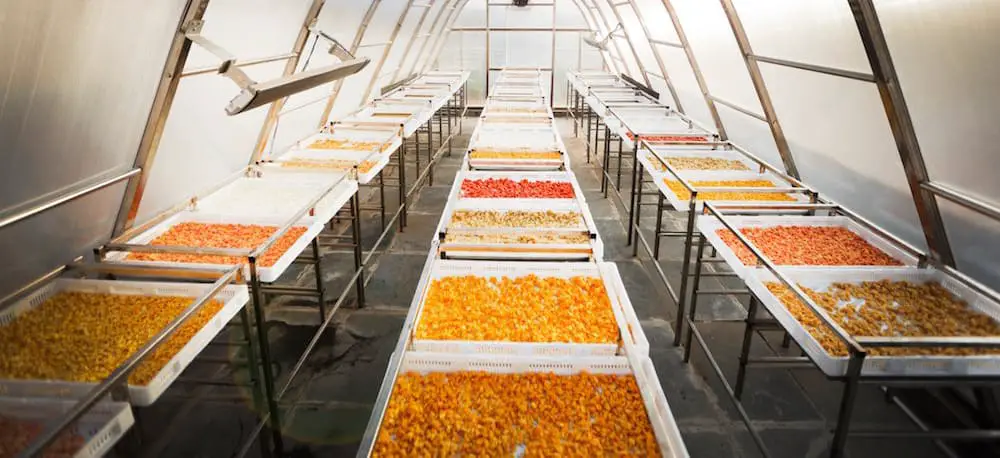
The temperature inside the structure reaches on average 15-20 ° C higher than the outside temperature. The system is lined with polycarbonate sheets to effectively filter UV rays and protect the material that could otherwise affect the final quality of the dehydrated product.
The ventilation system ensures air circulation inside the greenhouse and eliminates humidity. This is 100% powered by greenhouse solar panels. Farmers only need to arrange their produce in the greenhouse, and the sun does the rest.
Drying or dehydrating agricultural products is one way to protect them. Post-harvest losses of agricultural products, especially fruits, vegetables and other perishable products, are estimated to amount to more than $ 14 billion in India alone. For the poorest farmers, this can mean the loss of their only source of income.
This technology can also help exports to increase the income of small farmers. In South India, 70 small farmers are already benefiting from this technology, making the most out of their crops. The goal in India is to double the income of farmers by 2022 while reducing food waste, making it a perfect example of a solution with clear environmental and economic impact, an efficient solution in every way.
Durability of the panels
How do solar panels withstand strong winds?
In one of the most common designs for a greenhouse solar panels system, the modules are typically mounted parallel to the roof. There is usually little space between the bottom of the panel and the roof surface. This helps the panel assembly remain highly stable. This type of installation causes strong winds to slide over the panels without creating too much upward force. Another impressive fact about installation is that solar modules can withstand winds of up to 225 kilometers per hour before they start to have problems.
Even if the wind exerts a great force, there are industrial strength bolts that hold the unit to the roof, firmly securing the solar modules. The combination of the most aerodynamic design possible and proper fitment by the installer ensures that the solar modules will remain on the roof as long as the roof remains in good condition during an extreme storm. The most common reason a system cannot withstand high winds is due to installer error.
Are solar panels hail proof?
Weather resistant solar panels are simply solar panels, which means that there is no special type that you can buy that is specifically resistant to hail. The engineers who design solar modules take special precautions to ensure that the surface layer of glass is highly resistant to being hit by a variety of objects, including hail. The ability to include glass that is transparent enough to allow light to pass through while still being strong enough to be resistant to objects like hail is one of the considerations manufacturers take into account.
More stories like this
- Do solar panels work at night? The anti-solar panels
- AMD Zen 3 vs Zen 4: The evolution and revolution
- What is the AMD FidelityFX Super Resolution?
- CES 2022: The year’s most anticipated tech event
- Graphene Aerogel: the lightest material on earth
- IBM optical circuits: Next-gen computers powered by light